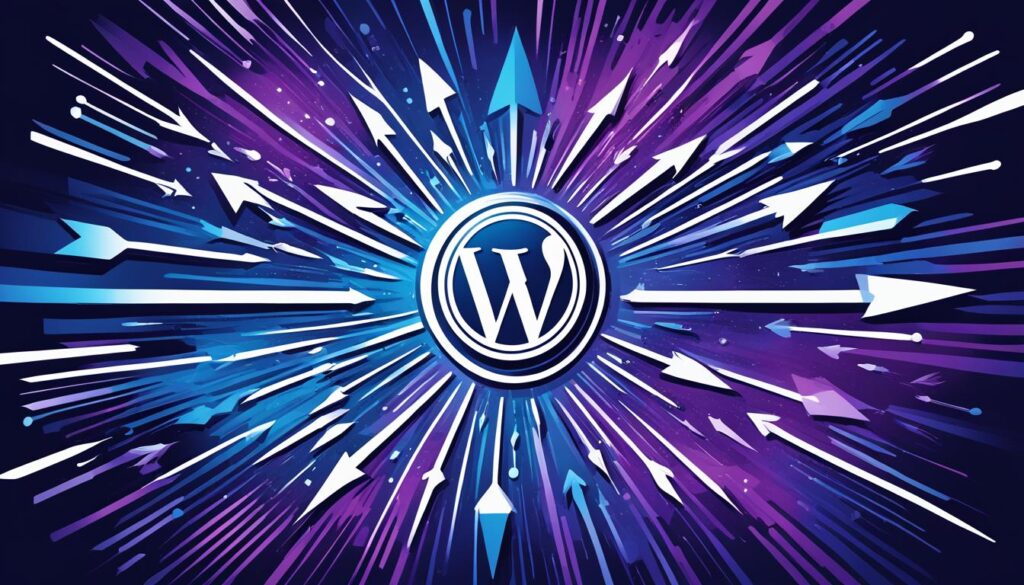In the fast-paced digital world where milliseconds can lead to major turning points for your online presence, speeding up your WordPress site has become an essential practice. It’s not just about keeping your visitors engaged; it’s about enriching their experience from the moment they land on your webpage. This underscores the pressing need for adept WordPress optimization and thorough WordPress performance tuning. The era we navigate today does not forgive sluggishness, nor does it spare any mercy for websites that leave users waiting.
Indeed, loading time is not merely a convenience but rather a significant driver of website success metrics. For a WordPress website seeking to flourish, closing in on fleeting attention spans and gaining favor in the eyes of elusive search engine algorithms, optimization reveals itself as a non-negotiable aspect. Recognizing this, we embark on elucidating the transformative steps of revamping your WordPress website for ruthless efficiency and blistering speed. A pursuit that is poised to yield measurable improvements in user retention, engagement, and search rankings.
Key Takeaways
- Understanding the indispensable role of site speed and its direct influence on user retention and SEO.
- Building the foundation for sustained digital triumph through refined WordPress optimization efforts.
- Appropriating the elite tactics meant for WordPress performance tuning to stay ahead in the competitive landscape.
- Garnering the hands-on expertise to transform your WordPress site into a beacon of expediency and promptness.
- Seizing control of your website’s destiny by meticulously refining every component that contributes to page load time.
- Preparing to unravel the comprehensive guide that navigates through the robust steps to an optimized WordPress experience.
The Importance of Speed in User Experience and SEO
As the online landscape becomes increasingly competitive, the need to improve website performance is more critical than ever. Website speed is a dominant factor that can either entice visitors to stay longer or compel them to abandon a site. A high optimal website loading time is not just a user experience (UX) consideration; it is also a significant component of search engine optimization (SEO).
To illustrate, every extra second of loading time can significantly increase the site’s bounce rate, which is the percentage of visitors who navigate away from the site after viewing only one page. Websites that load within 2 seconds tend to have an average bounce rate of 9%, whereas that figure leaps to 38% for sites that take 5 seconds to load. This stark difference underscores the necessity of speeding up your overall site to retain visitors.
Moreover, speed plays a critical role in how websites are indexed and ranked by search engines like Google. Faster sites are rewarded with higher search result rankings, thereby increasing the site’s visibility and potential organic traffic. This direct correlation speaks volumes about the importance of optimized site speeds for both user retention and SEO success.
“Site speed is a ranking signal for search engine algorithms, confirming that faster sites are favored in search results.”
- Preserve user engagement by improving page load times.
- Optimize website loading time to reduce bounce rates.
- Increase site speed to make a positive impression on new visitors.
- Understand and respond to the critical correlation between site speed and SEO rankings.
Ensuring that your website loads quickly is not just a technical detail—it’s a fundamental aspect that impacts both the user experience and your site’s ability to rank well in search engines.
Initial Steps to WordPress Speed Optimization
Embarking on a journey to supercharge your WordPress website’s performance can seem daunting, but by breaking down the process into manageable steps, you can significantly enhance WordPress site speed. A methodical approach is essential, beginning with a thorough assessment of your site’s current speed and performance metrics.
Evaluating Current Website Performance
To lay the groundwork for WordPress speed optimization, start by using performance measurement tools such as Google PageSpeed Insights. These tools provide invaluable insights into your website’s speed and critical areas for improvement. They analyze content and give you actionable feedback, thus allowing you to identify specific issues that bog down your site’s loading time.
Choosing the Right Hosting Solution
Every seasoned webmaster knows that hosting is the bedrock of any high-performing website. An optimal hosting solution is one that provides robust server performance, adequate resources, and scalability to accommodate traffic growth. Assess different hosting providers and select one renowned for its reliability and speed, which will inherently boost WordPress speed.
Updating WordPress: The Significance of Keeping Your Core Updated
An often-overlooked aspect of WordPress speed optimization is the regular updating of the core platform. New releases not only patch security vulnerabilities but also bring performance enhancements that can streamline your website’s operations. Vigilance in maintaining your WordPress version current is essential for a secure and agile online presence.
The path to enhancing your WordPress site speed is paved with these initial, yet significant steps. Rigorous attention to website performance evaluations, wise hosting choices, and consistent updates form the tripod on which the structure of a well-optimized WordPress site stands.
Selecting and Optimizing WordPress Themes for Speed
When striving to optimize website loading time, one cannot overlook the significant role that WordPress themes play in site performance. The theme you choose sets the foundation for your site’s design, features, and of course, speed. In this section, we’ll explore strategies to select themes that are coded for performance and offer tips on how to fine-tune them for even better speed metrics.
Lightweight Themes and Speed
Opting for a lightweight theme is a key step in WordPress theme optimization. A theme stripped down to the essentials eliminates unnecessary functionalities that can slow down your site. Let’s take a closer look at why choosing a minimalistic approach to your theme can pay off in loading speeds:
- Reduced server requests due to fewer images, scripts, and stylesheets.
- Faster response times with simplified and efficient code.
- Better compatibility with performance-enhancing plugins and tools.
It’s about striking a balance between aesthetics and functionality, ensuring that website performance remains a top priority.
Theme Best Practices: Simplify Design Elements
Even after selecting a fast-loading theme, there’s room for further speed gains. Streamlining design elements within your theme is a critical step in reducing load times. Here are some best practices:
- Avoid heavy use of sliders and carousels that require additional scripts.
- Minimize the use of widgets where a simpler HTML/CSS alternative exists.
- Opt for CSS3 effects over images when possible to cut down on file requests.
Attention to these details ensures not only a visually appealing site but one that also loads with impressive speed.
Speeding up WordPress Site with Caching Solutions
For any WordPress website owner aiming to boost WordPress speed, employing robust WordPress caching solutions is crucial. Caching serves as an effective strategy to diminish server load and slash the page load time, providing a more brisk browsing experience to your audience. By retaining a static copy of your website’s content, caching mechanisms allow returning visitors to enjoy faster access, thus improving both user experience and website performance metrics.
Various caching types exist, each catering to different components of a WordPress site. Below we outline some of the most impactful caching methods:
- **Page Caching**: Stores fully generated HTML pages on the server, reducing the number of PHP calls and database queries needed.
- **Database Caching**: Reduces the time taken to fetch data from the website’s database by storing the results of queries.
- **Object Caching**: Keeps frequently used objects such as menus, widgets, or certain APIs loaded in memory for quick retrieval.
- **Opcode Caching**: Compiles PHP code and stores it, cutting down on the processing time with each request.
To implement these caching strategies, WordPress site administrators can choose from numerous caching plugins renowned for their efficiency and ease of use. Popular options include W3 Total Cache, WP Super Cache, and WP Rocket, each providing a suite of tools to tailor caching practices to your specific needs. Experimenting with these can lead to significant reductions in page load times, thereby helping to solidify your site’s reputation for speed and reliability.
Moreover, it’s important to remember that caching is not just a ‘set-and-forget’ solution; regular assessments and adjustments ensure that caching mechanisms remain tuned to your site’s changing content and traffic patterns. Thoughtful configuration and periodic reviews help to maintain an optimal caching setup capable of adapting to varying loading demands.

A proactive approach to caching will not only enhance the speed of a WordPress site but will also contribute to a better search engine ranking. Through strategic caching, your site can enjoy increased visitor satisfaction and a competitive edge in today’s fast-paced digital space.
Considering the substantial benefits caching delivers, it’s an indispensable tool for any webmaster focused on elevating their WordPress site’s performance and climbing the SEO rankings ladder.
WordPress Plugins: Optimizing, Minimizing, and Selecting the Right Ones
With a vast array of WordPress plugins available at your fingertips, it’s critical to cherry-pick those that offer the best synergy of functionality without compromising on your website’s performance. Optimizing your WordPress site goes beyond selecting feature-rich plugins; it’s about making calculated choices that boost WordPress speed and efficiency.
Choosing Performance-Friendly Plugins
Seeking out plugins that are designed with performance in mind is paramount. Here are a few aspects to consider when selecting plugins:
- Check the ratings and reviews for performance-related feedback.
- Look for developers who have a reputation for creating efficient plugins.
- Analyze the plugin’s update history to ensure regular maintenance.
Selecting carefully could be the difference between a sluggish site and a swift, agile platform. Not all plugins are created equal—some are inherently optimized for speed, allowing you to enjoy extended functionality without significantly dragging down loading times.
Auditing Existing Plugins for Performance Impact
Conducting an audit on your current plugins can reveal a lot about how they affect your website’s speed. Consider the following steps for a thorough evaluation:
- Use a performance testing tool to identify any plugins slowing down your site.
- Deactivate and test individual plugins to measure their impact on your load time.
- Seek out alternative plugins if current ones are found detrimental to speed.
Trimming down on unnecessary plugins or replacing them with more efficient options can significantly boost WordPress speed and user experience. By conducting regular performance audits, you ensure that only the most beneficial plugins remain active on your site, fostering a robust yet streamlined digital environment.
Optimization is a continuous process; it demands vigilance and a proactive approach to plugin management—key steps towards a lightning-fast WordPress experience.
Optimize Website Loading Time Through Image Optimization
As digital landscapes become increasingly visual, image optimization is essential for enhancing WordPress site speed. Large, unoptimized images are notorious for slowing down websites. By compressing image file sizes and ensuring they’re appropriately scaled, webmasters can significantly improve page loading times and enhance user experience, while also benefiting SEO.
Image Compression Tools
Choosing the right image compression tools is a critical step towards improving website load times. These tools work by reducing image size without compromising on quality, which is vital to maintaining the visual appeal of your site. Some popular tools include Adobe Photoshop, which offers substantial control over image quality and file size, and online compressors like TinyPNG or JPEGmini that are user-friendly and effective.
Correct Sizing and Scalability in Images
Equally important is ensuring that images are of correct dimensions and scalable to suit different devices. Upload images that are algorithmically optimized to adjust to various screen sizes and resolutions, thus enhancing WordPress site speed. Utilizing CSS techniques like srcset attributes can offer multiple options for the browser to choose from, ensuring that only the most appropriate image size is downloaded on a particular device.
- Use responsive images with srcset and sizes attributes
- Select appropriate file formats (e.g., JPEG for photos, PNG for graphics)
- Implement SVGs for vector images for scalability without loss of quality
Adhering to these practices will offer a better browsing experience, which is crucial, as faster-loading sites keep users engaged and can lead to higher conversion rates.
Boost WordPress Speed with CDN Integration
To effectively accelerate your WordPress site, CDN integration stands out as a game-changing strategy. By opting for Content Delivery Networks (CDNs), you leverage a network of servers positioned globally to deliver your site’s content. This distribution mechanism bridges the gap between your visitors and the server resources needed to render your website, resulting in significantly reduced load times. Not only does it streamline content delivery by serving data from the nearest geolocated server, but it also ensures greater uptime and performance stability during traffic spikes or DDoS attacks.
Why does CDN integration matter? At its core, a CDN takes on the heavy lifting of data transfer, allowing your single hosting server to breathe and function without the strain of handling countless simultaneous requests. This means an enhanced user experience due to faster page loads, which is a critical factor in retaining visitors and improving search engine rankings.
Remember, a fast site contributes to a happy visitor, and a happy visitor is more likely to convert, engage, or become a return user.
- Global Reach – A CDN puts your content on the map, quite literally, ensuring fast delivery regardless of geographical location.
- Scalability – Whether your WordPress site experiences a steady flow of traffic or sudden surges, CDNs offer the scalability to handle it effortlessly.
- Redundancy – With multiple servers at work, CDNs provide redundancy that protects against site outages or performance dips.
- Security – CDNs often come with enhanced security features to help guard against common web threats.
Integrating a CDN with your WordPress site isn’t just about speeding things up; it’s about constructing a robust platform capable of delivering optimal performance to a global audience. Let’s not forget, in the competitive digital age, the swiftness of your site can very well be the deciding factor between you and your competitors.
As you pursue the goal to accelerate your WordPress site, embrace CDN integration as more than just an enhancement; consider it an investment in your digital presence. By doing so, you’ll ensure that your site not only performs exceptionally but also meets the speed and reliability demands that users and search engines value highly.
Database Optimization in WordPress
A WordPress website’s database is a vital component that, when optimized, can significantly improve website performance. Regular maintenance of the database not only streamlines your site’s operations but also enhances the user experience by providing swiftly loaded pages.
Cleaning Up the Database
Over time, a WordPress database can accumulate unnecessary data that bogs down its efficiency. A primary step in WordPress database optimization is the removal of excess baggage such as post revisions, spam comments, and transient options. A clean database runs more efficiently, allowing for faster data retrieval and improved website responsiveness.
- Post Revisions: Limiting or deleting old revisions can significantly reduce database size.
- Spam Comments: Permanently deleting comments marked as spam will free up space.
- Transient Options: These are temporary data mostly used by plugins, which can be cleared out.
- Unused Database Tables: Remove tables left behind by uninstalled plugins.
Periodic Maintenance Tasks
For optimal performance, your WordPress database requires regular check-ups and maintenance. This involves more than just a casual sweep; it necessitates a systematic approach to ensure that every aspect of the database is functioning at its peak capability.
- Database Backup: Before making changes, ensure you have a recent backup.
- Database Optimization: Run optimization commands or use dedicated plugins to defragment tables and reclaim unused space.
- Regular Cleanups: Schedule regular cleanups to maintain a lean database structure.
- Monitoring and Troubleshooting: Keep an eye on your database’s performance over time to identify and solve issues promptly.
By adhering to these WordPress database optimization practices, you not only improve website performance but also secure a solid foundation for your website’s continued growth and success.
Minimizing and Combining CSS and JavaScript Files
Improving WordPress performance tuning efforts can start with critical optimizations of CSS and JavaScript files. A common challenge that often hampers website speed is the excessive number of these files making separate HTTP requests. When a user visits your WordPress site, their browser fetches data from the server, and if there are numerous CSS and JavaScript files, it results in a longer wait time.
Minimizing CSS and JavaScript is essential not only for reducing the number of HTTP requests but also for decreasing the overall file size. This process involves removing all unnecessary characters from these files, such as whitespace, line breaks, and comments, to create a compressed version that executes the same functionality in a more efficient manner.
Combining multiple CSS and JavaScript files into single or fewer files is another crucial step in this optimization process. This not only reduces the number of server requests but also helps in maintaining a cleaner and more manageable codebase. Moreover, modern development practices endorse the use of modular programming combined with build tools to concatenate and minify resources.
By implementing such techniques, you effectively sharpen your approach to WordPress performance tuning, ensuring that the site’s user experience is as responsive and fluid as possible.
- Analyze and identify all the separate CSS and JavaScript files loaded on your site.
- Utilize tools and plugins designed for WordPress to minimize and combine these files.
- Conduct thorough testing to ensure functionality remains intact post-optimization.
In conclusion, thoughtful consolidation and minimization reflect best practices in website performance, leading to faster page load times and a more polished user interaction. As these technical enhancements take place under the hood, they collectively work towards a seamless and engaging experience that users expect—and Google rewards—in today’s digital world.
Accelerate WordPress Site by Utilizing Browser Caching
When it comes to WordPress speed optimization, one of the most effective practices is leveraging browser caching. This technique involves storing static files like HTML, CSS, and JavaScript in the local cache of the visitor’s browser. As a result, when users revisit your WordPress site, the browser doesn’t have to reload the entire page, thereby significantly reducing loading times and enhancing the user experience.
Leveraging Browser Caching
To implement browser caching, WordPress site administrators can utilize various plugins or manually edit configuration files. By setting specific rules for how browsers should handle different types of content, you indicate when the browser should request a new version of the file or serve it from the cache. Proper implementation of caching rules ensures that returning visitors will enjoy quicker access to your content, reflecting positively on your site’s performance metrics.
Expires Headers and ETags
Expires Headers and ETags are two methods of managing browser caching that can be added to your server’s configuration. Expires Headers tell the browser how long to keep the cached files before they are considered outdated, while ETags are validation tokens that browsers use to determine if the content has changed since the last download. Implementing these will allow your server to instruct visiting browsers on how to make more efficient use of their cache, thereby accelerating your WordPress site.
- Identify and prioritize the resources that can be cached.
- Use plugins or manual edits to enable Expires Headers for static resources.
- Configure ETags to validate cached resources efficiently.
By understanding and applying the principles of browser caching, you could deliver content faster to your audience, improving both the user experience and your site’s search engine ranking. Keep in mind that while caching is powerful, it’s just one piece of the WordPress speed optimization puzzle.
Enhance WordPress Site Speed Through Lazy Loading and Deferred JavaScript
Improving your WordPress website’s speed is essential in providing a better user experience and improving search engine rankings. One effective strategy to achieve this is by implementing WordPress lazy loading and deferring JavaScript. Lazy loading is a technique that delays the loading of non-critical resources at page load time. Instead, these resources are loaded only when needed, such as when they enter the viewport of the user’s browser. This can significantly reduce initial page load time, lower bandwidth usage, and improve site performance.
On the other hand, deferring JavaScript involves delaying the execution of JavaScript files until after the initial rendering of the page. This ensures that any scripts that are not essential to displaying the above-the-fold content do not interfere with the loading of the main content of your site. Together, lazy loading and deferred JavaScript can help you optimize resource loading and enhance site speed massively.
“Lazy loading and deferred JavaScript are among the most effective enhancements that can be made to improve website load times and site performance. They align with best practices for speeding up WordPress websites as recommended by web performance experts.”
- Lazy loading prioritizes the user’s immediate viewing area, loading other elements as they become necessary.
- Deferring JavaScript allows the browser to first display the site’s content, improving perceived performance.
WordPress Performance Tuning with Advanced Techniques
When it comes to fine-tuning your WordPress site, several advanced strategies stand out for their ability to drastically improve performance. Two such methods are the utilization of GZIP compression and the meticulous adjustments possible with the .htaccess file. These are not quick fixes, but rather potent tools in the arsenal of those who demand peak performance from their WordPress sites.

Implementing GZIP Compression
Enabling GZIP compression can make a noticeable difference in your site’s loading speed by compressing your web pages and style sheets before sending them over to the browser. This server-side optimization technique not only accelerates the transfer of information but also conserves bandwidth, leading to an enhanced user experience. It’s a staple of advanced WordPress optimization that savvy site owners should not overlook.
Fine-Tuning with .htaccess File Adjustments
For those who are comfortable with editing server files, .htaccess optimizations present a multitude of opportunities to improve performance. This configuration file, critical for WordPress installations, allows for directives to be implemented such as redirect rules, security enhancements, and of course, performance tweaks. For instance, through the .htaccess file, one can set up proper caching headers and enable or disable additional compression methods, competently streamlining the communication between server and client.
- Enable Keep-Alive: to allow connections to transfer multiple files without reinitiating connections.
- Redirects Optimization: to reduce latency due to fewer HTTP requests.
- File Etags: to determine whether a file has changed, rather than relying on the cached version.
Conclusion
In the digital age, where milliseconds can determine whether a visitor stays or bounces, speeding up your WordPress site is not just an option; it’s a necessity. This comprehensive guide has navigated you through a journey of WordPress optimization, from the initial steps of evaluating current website performance to advanced techniques like GZIP compression and .htaccess file adjustments. Each strategy presented serves a single unified goal: to enhance the performance and user experience of your WordPress site.
Whether you are new to the concept of website optimization or are looking to refine your existing knowledge, the methodologies elaborated here give you the tools to not only improve loading times but also to contribute positively to your SEO efforts. It’s essential to understand that the task of WordPress optimization is an ongoing one, where regular monitoring and updates align with the dynamic nature of web technologies and user expectations.
As we wrap up, remember that a fast-loading website is a gateway to higher user satisfaction, reduced bounce rates, and improved search engine rankings. Implementing the insights provided in this guide will place you on the trajectory to success, ensuring your WordPress site stands out in the competitive digital landscape. It’s time to take action, apply these strategies, and witness the transformation in your website’s performance for yourself.
FAQ
Why is a fast-loading WordPress site important?
A fast-loading WordPress site is crucial because it enhances user experience by reducing bounce rates, increasing time-on-site, and positively affects search engine rankings by meeting speed factors considered by algorithms like those of Google.
How can I initially assess the speed of my WordPress website?
You can assess your website’s speed by using tools such as Google PageSpeed Insights, which provides metrics on your site’s current performance and offers suggestions for improvement.
Does the choice of web hosting affect WordPress site speed?
Absolutely. Selecting the right hosting solution is essential, as it can align with your website’s performance needs and handle the traffic efficiently, thereby improving site speed.
Are there specific WordPress themes that are better for site speed?
Yes, choosing a lightweight theme that follows simplified design practices can drastically reduce loading times and contribute to a faster WordPress site.
How does caching improve WordPress performance?
Caching reduces page load times by storing a static version of the content, which minimizes the number of server requests and accelerates content delivery to returning visitors.
What role do plugins play in WordPress site speed?
Plugins can have a significant impact on site speed. It’s important to select performance-friendly plugins, regularly audit existing ones for their performance impact, and minimize their number to avoid bloat.
Can image optimization make a significant difference in site speed?
Yes, optimizing images through compression and proper sizing can make a substantial difference, as images often account for the majority of a web page’s size.
How does a CDN accelerate a WordPress site?
A CDN delivers site content from servers closest to the website visitor, reducing the distance data has to travel, which can significantly boost loading speeds.
What is WordPress database optimization and why is it needed?
WordPress database optimization involves cleaning up unnecessary data and performing regular maintenance tasks to ensure efficient data retrieval, which can improve website speed and performance.
Why should I minimize and combine CSS and JavaScript files?
Minimizing and combining CSS and JavaScript files decreases the number of server requests and reduces file sizes, which speeds up page loading times.
What is browser caching and how does it help WordPress sites?
Browser caching stores webpage resources on a user’s local computer, so when they revisit the page, the content loads faster because it doesn’t have to be downloaded again.
What are lazy loading and deferred loading of JavaScript?
Lazy loading delays the loading of non-critical resources until they are needed, while deferring JavaScript delays the execution of JavaScript files until the main content has loaded. Both techniques improve initial page load times.
Are advanced techniques like GZIP compression and .htaccess file adjustments useful for WordPress speed optimization?
Yes, advanced techniques such as GZIP compression, which compresses web pages and resources, and .htaccess file adjustments can fine-tune server performance for an optimized browsing experience.



